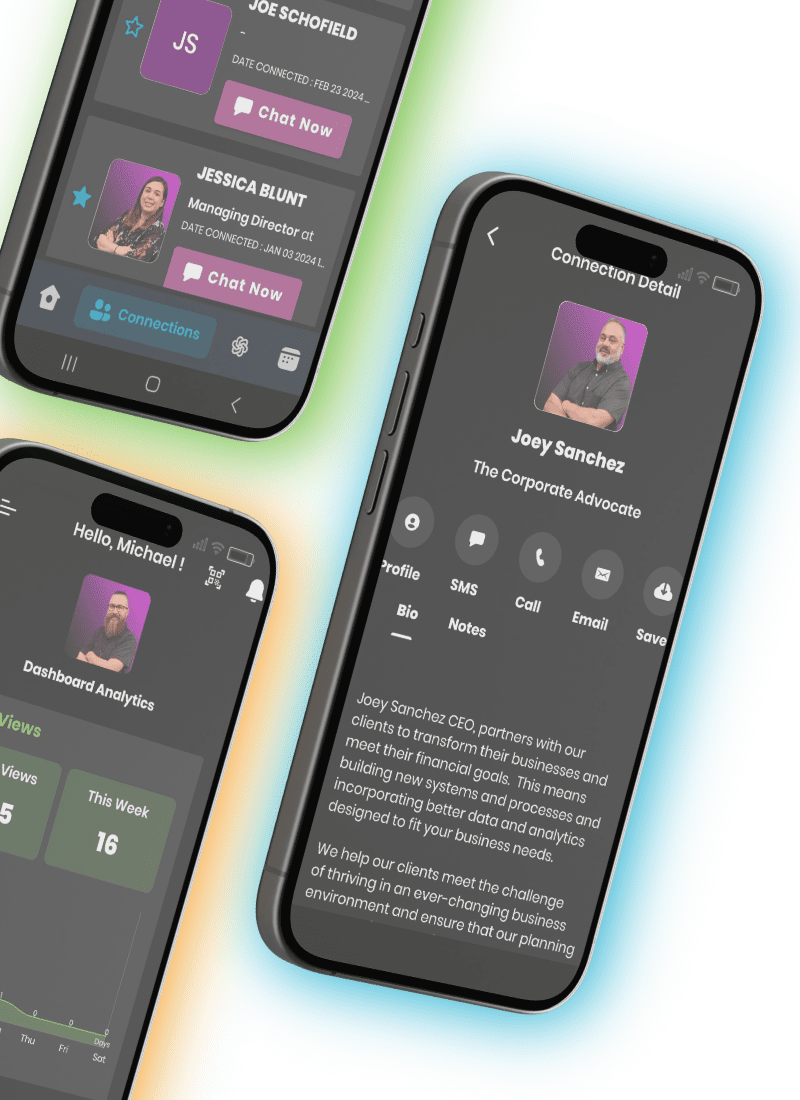In the dynamic landscape of professional growth, networking serves as the linchpin for building meaningful connections and unlocking valuable opportunities. Effective networking, however, extends beyond the initial handshake and exchange of business cards; it hinges on the art of follow-up. This article is your guide to mastering the delicate yet powerful skill of effective networking follow-up. By understanding its importance and implementing actionable strategies, you can transform casual connections into enduring professional relationships.
Setting the Stage for Follow-Up Success
Building Genuine Connections
Networking isn’t just about exchanging pleasantries; it’s about forming authentic connections. Whether you’re at a conference, industry event, or a local meetup, prioritize genuine interactions over a quantity of contacts. Authenticity lays the groundwork for follow-up success, making your connections more receptive to your future engagement.
Collecting Contact Information Strategically
Once you’ve made a meaningful connection, the next step is to collect contact information strategically. Leverage digital tools for efficient contact management, ensuring you have the necessary details to foster a strong follow-up. Remember, the goal is to make the process seamless, not intrusive, so be tactful in obtaining the information you need.
Making Immediate Post-Event Notes
The immediacy of your follow-up can significantly impact its effectiveness. Develop a habit of jotting down key points about your new connections immediately after the event. This could include shared interests, potential collaborations, or even personal details that could strengthen your rapport. These post-event notes will become invaluable when crafting personalized follow-up messages.
By establishing a solid foundation through genuine connections, strategic contact collection, and immediate post-event notes, you set the stage for a follow-up that goes beyond the perfunctory exchange of emails.
The Foundation: Setting the Stage for Follow-Up Success
Collecting Contact Information Strategically
In the realm of professional networking, the strategic collection of contact information is akin to assembling the building blocks of enduring connections. Efficient contact management is crucial for seamless and effective follow-up. Leveraging both traditional and digital methods, you can ensure that you have the necessary details to nurture and expand your network.
Utilize Digital Tools for Efficient Contact Management
As we navigate the digital age, utilizing tools for contact management has become paramount. Invest time in exploring and adopting customer relationship management (CRM) systems or dedicated apps designed for networking professionals. These tools can help organize contacts, track interactions, and set reminders for follow-ups, ensuring that no valuable connection slips through the cracks.
Networking Apps: Your Pocket-Sized Rolodex
Networking apps have become indispensable for professionals aiming to streamline their contact management process. Platforms like SyncVIP, for example, not only serve as a digital business card but also offer features to categorize connections, add notes, and set reminders. Embrace these apps as extensions of your networking strategy, enhancing your ability to stay connected and informed.
Making Immediate Post-Event Notes
While the digital realm aids in contact management, the analog act of making immediate post-event notes remains a potent tool for effective follow-up. These notes act as the bridge between the initial encounter and the follow-up email, adding a personalized touch to your outreach.
Develop a Structured Note-Taking System
Consider creating a structured system for your post-event notes. Include essential details such as the person’s name, company, and a distinctive feature or conversation point that will jog your memory later. Whether it’s a dedicated notebook or a note-taking app, having a consistent system enhances recall when it’s time to reconnect.
Templates for Timely Post-Event Notes
Crafting post-event notes promptly requires a template that balances efficiency with personalization. Develop a template that incorporates basic details, a reference to the event, and a brief mention of shared interests or potential collaboration points. Having a template at your disposal ensures timely follow-up without sacrificing the sincerity of your message.
The Importance of Immediacy
The clock is ticking after every networking event. The sooner you jot down your thoughts and observations, the fresher the details will be in your mind. Consider your post-event notes as a time-sensitive deposit into your memory bank, ensuring you don’t lose the nuances of your interactions. Aim to complete your notes within 24 hours to maximize their impact.
What to Include in Your Notes
Your post-event notes should be a snapshot of the encounter, capturing both professional and personal aspects. Include basic details such as the person’s name, job title, and company, but don’t stop there. Add a unique identifier—something distinctive about the individual or the conversation that sets them apart. Did you discuss a shared hobby, a recent accomplishment, or a potential collaboration? These details will serve as the foundation for your personalized follow-up.
Balancing Brevity and Detail
Strive for a balance between brevity and detail in your post-event notes. While you want them to be comprehensive, you also don’t want the process to be time-consuming. Develop a shorthand or use bullet points to encapsulate key information efficiently. Remember, these notes are not an exhaustive biography but rather prompts to trigger your memory during follow-up.
A Template for Note-Taking After Networking Events
To streamline the post-event note-taking process, consider implementing templates or systems tailored to your preferences. Having a structured framework ensures consistency and expedites the note-taking ritual. Here’s a simple template to get you started:
Post-Event Note Template:
Basic Information:
- Name:
- Job Title:
- Company:
Distinctive Details:
- Shared Interests:
- Noteworthy Conversations:
- Potential Collaborations:
Follow-Up Action Items:
- Reference Points for Follow-Up:
- Ideas for Future Engagement:
Implementing such a template can turn post-event notetaking from a daunting task into a systematic and manageable process.
The Art of Effective Follow-Up: 9 Actionable Steps
Step 1: Personalized Follow-Up Emails
The first step in mastering effective networking follow-up is crafting personalized emails that go beyond generic templates. Here, we will explore the intricacies of creating emails that resonate with your connections, leaving a lasting impression.
The Power of Personalization
Begin your follow-up emails by addressing your connection by their name. This simple act immediately sets a personal tone, showing that your message is tailored specifically for them. Reference the event or context in which you met, reinforcing the memory of your initial encounter.
Acknowledging Shared Interests or Conversations
Infuse your email with a touch of familiarity by acknowledging shared interests or memorable conversations. This not only demonstrates your genuine interest but also serves as a powerful recall trigger for your connection. Whether it’s a shared passion for a certain industry trend or a discussion about mutual goals, highlighting these points strengthens the connection.
Avoiding Generic Language
Steer clear of generic language that could be mistaken for a mass email. Tailor your message to reflect the unique aspects of your relationship with the recipient. Avoid excessive use of clichés or overly formal language. Instead, aim for a conversational tone that aligns with the rapport you established during your initial meeting.
Step 2: Timeliness Matters
Beyond personalization, the timing of your follow-up plays a pivotal role in its effectiveness. In this section, we’ll delve into the art of timely follow-ups, ensuring your connections remain engaged and receptive to your outreach.
Striking the Right Balance
While immediate follow-ups are crucial, it’s equally important to strike the right balance. Rushed or overly prompt follow-ups may come across as insincere, lacking the thoughtful consideration needed for a lasting connection. Aim to send your follow-up email within 48 hours of the initial meeting, allowing enough time for reflection while maintaining the momentum.
Considering the Context
Take into account the context of your initial interaction when determining the timing of your follow-up. If the conversation involved specific timelines or upcoming events, align your follow-up with these contextual cues. This demonstrates not only your punctuality but also your attentiveness to the details discussed.
Crafting Follow-Up Sequences
In certain scenarios, consider crafting follow-up sequences rather than a single email. This approach allows you to gradually unfold your engagement, providing valuable information or insights in a series of well-timed messages. However, ensure each email in the sequence adds value and maintains the personal touch.
Step 3: Reference Shared Interests or Conversations
As we delve deeper into the intricacies of effective networking follow-up, referencing shared interests or conversations emerges as a pivotal step. This section explores how to seamlessly incorporate these references, transforming your follow-up communication into a personalized and memorable exchange.
The Personal Touch of Shared Interests
Begin your follow-up by revisiting shared interests discussed during your initial meeting. Whether it was a common passion for a particular industry trend, a shared hobby, or a mutual professional goal, referencing these points establishes a personal connection. This not only reinforces your genuine interest but also reinforces the positive memory of your interaction.
Strategies for Natural Incorporation
Integrate references to shared interests organically within your follow-up communication. Avoid forcing these references or making them feel like an obligatory checklist. Instead, let them flow naturally within the context of your message. This approach ensures that your connection recognizes the authenticity of your engagement.
Highlighting Continued Interest
Use shared interests as a bridge to express your continued interest in the relationship. Whether it’s proposing collaboration on a project related to a shared interest or sharing relevant resources, this step showcases your commitment to nurturing the connection beyond the initial encounter.
Step 4: Offer Value in Your Follow-Up
Building on the foundation of personalized communication, the next step in effective networking follow-up is to offer value. This section explores how to add substance to your interactions, ensuring that each follow-up contributes positively to the relationship.
The Principle of Reciprocity
Acknowledge the principle of reciprocity in networking. Offering value in your follow-up creates a positive cycle where each party benefits from the relationship. This could involve sharing industry insights, relevant articles, or introducing your connection to valuable contacts within your network.
Sharing Resources and Insights
Identify ways to share resources and insights that align with your connection’s interests or professional goals. Whether it’s an article, a webinar, or an upcoming event, providing valuable information demonstrates your commitment to mutual growth. Be genuine in your intent to contribute to your connection’s success.
Striking a Balance
While offering value is essential, strike a balance to avoid overwhelming your connection with excessive information. Tailor your contributions to their preferences and priorities. Consider asking for their preferences explicitly, ensuring that your follow-up adds meaningful value without becoming intrusive.
Step 5: Utilize Social Media Strategically
In the digital age, leveraging social media is a crucial aspect of effective networking follow-up. This section explores strategic ways to utilize platforms like LinkedIn and Twitter to enhance and maintain professional connections.
The Role of Social Media in Networking Follow-Up
Social media platforms serve as virtual networking hubs, offering opportunities to stay connected beyond traditional email correspondence. Understanding the dynamics of each platform and employing them strategically can amplify the impact of your follow-up efforts.
Connecting on Professional Platforms
LinkedIn, being a professional networking powerhouse, is a primary platform for strategic follow-up. Send personalized connection requests, referencing your initial meeting, and express your interest in maintaining a professional connection. Ensure your profile is updated and aligned with your networking goals.
Engaging with Connections Online
Beyond connecting, active engagement is key. Regularly interact with your connections’ posts, share relevant content, and participate in industry discussions. This not only keeps you visible but also demonstrates your genuine interest in their professional endeavors. Strike a balance between being present and respectful of their online space.
Step 6: Schedule a Follow-Up Meeting or Call
Elevating your networking game involves moving beyond digital interactions. This section explores the importance of scheduling follow-up meetings or calls to deepen the connection and explore potential collaborations.
Advocating for a Next-Level Connection
Express your interest in taking the relationship to the next level by suggesting a follow-up meeting or call. This step demonstrates your commitment to investing time and effort in the connection. Propose specific topics or activities that align with your shared interests or professional objectives.
Strategies for Proposing and Scheduling
Craft your proposal for a follow-up meeting or call with clarity and conciseness. Propose a few available time slots or suggest a flexible scheduling tool to streamline the process. Be mindful of your connection’s schedule and time zone, ensuring a smooth and convenient arrangement.
Ensuring Mutual Benefit
Highlight the mutual benefit of the follow-up meeting or call. Whether it’s discussing potential collaborations, sharing insights, or exploring ways to support each other’s endeavors, emphasize the value each party can derive from the interaction. Mutual benefit strengthens the foundation of a sustained professional relationship.
Step 7: Join Relevant Networking Groups or Events
As we delve further into the realm of effective networking follow-up, actively participating in relevant networking groups and events emerges as a strategic move. This section explores the benefits and strategies for joining and engaging in these professional communities.
Encouraging Ongoing Engagement
Networking is not a one-time event; it’s an ongoing process. Joining industry-specific groups or attending relevant events provides a continuous avenue for engagement. Actively participate in discussions, share your insights, and offer support to fellow professionals. Consistent engagement keeps you on the radar of your network.
Benefits of Continuous Networking Efforts
Being part of networking groups offers multifaceted benefits. It provides opportunities for learning about industry trends, discovering potential collaborators, and staying informed about upcoming events. Additionally, it enhances your visibility within your professional community, opening doors to new connections and collaborations.
Identifying and Participating in Valuable Groups
Strategically choose the networking groups or events that align with your professional goals and interests. Research and identify platforms where industry leaders and like-minded professionals converge. Actively contribute to these groups, showcasing your expertise and building rapport with fellow members.
Step 8: Keep Your Network Informed
In the landscape of effective networking follow-up, staying connected involves keeping your network informed about your professional journey. This section explores strategies for sharing updates without coming across as overly promotional.
The Importance of Sharing Updates
Regularly updating your network about your professional endeavors is a form of transparency and communication. It allows your connections to stay informed about your growth, projects, and achievements. This proactive approach strengthens your professional relationships and fosters a sense of shared success.
Strategies for Sharing Updates
Craft updates that strike a balance between informative and engaging. Share milestones, achievements, or insights that align with your connections’ interests. Utilize platforms like LinkedIn to publish articles, share project updates, or even celebrate professional anniversaries. Be mindful of the frequency and relevance of your updates to maintain engagement.
Reciprocal Nature of Information Sharing
Encourage a reciprocal flow of information by expressing genuine interest in your connections’ updates as well. Engage with their posts, congratulate them on achievements, and offer support when needed. This two-way exchange strengthens the fabric of your professional network, fostering a culture of mutual support and growth.
Step 9: Express Gratitude and Maintain a Long-Term Mindset
As we approach the final steps of mastering effective networking follow-up, expressing gratitude and adopting a long-term mindset become paramount. This section explores the significance of gratitude in professional relationships and the enduring impact of maintaining a forward-thinking perspective.
Stressing the Significance of Expressing Gratitude
Expressing gratitude is not merely a courtesy; it’s a powerful tool in building and sustaining professional relationships. Your follow-up messages should not only be about your needs but should also express genuine appreciation for the time, insights, or opportunities your connections have shared with you. Gratitude lays the foundation for a positive and reciprocal professional relationship.
The Impact of Showing Appreciation
A heartfelt “thank you” can leave a lasting impression. Acknowledging the value your connections bring to your professional journey fosters a sense of goodwill. Whether it’s expressing gratitude for advice, support during a project, or simply for their time at a networking event, these gestures contribute to a positive networking dynamic.
Emphasizing the Long-Term Mindset in Building Relationships
Effective networking follow-up is not a one-off activity but a continuous process. Embrace a long-term mindset, viewing your professional relationships as ongoing partnerships. Consider the potential for collaboration, shared growth, and mutual support over the years. Building a robust professional network is an investment in your career that pays dividends over time.
Conclusion
As we bring our exploration of effective networking follow-up to a close, it’s essential to reflect on the journey we’ve undertaken. From the foundational steps of building genuine connections and strategically collecting contact information to the nuanced art of timely and personalized follow-up, each stage contributes to the intricate dance of professional networking.
In mastering the art of effective networking follow-up, you’ve discovered that success lies not only in the precision of your emails or the promptness of your follow-up but also in the authenticity and depth of your connections. The steps outlined in this guide serve as a roadmap, guiding you through the multifaceted landscape of networking relationships.
A Continuous Evolution
Networking, at its core, is a continuous evolution—a dynamic process that goes beyond a single event or interaction. It’s about weaving a tapestry of relationships, each thread representing a unique connection, shared experience, or collaborative endeavor. The significance of expressing gratitude and maintaining a long-term mindset underscores the enduring nature of these professional bonds.
Your Networking Odyssey
As you embark on your networking odyssey armed with the insights from this guide, remember that the true essence of networking lies in the people—the stories, experiences, and aspirations that collectively shape the professional landscape. Each follow-up is an opportunity to nurture these connections, contributing not only to your individual growth but also to the collaborative tapestry of your professional community.
Continual Growth and Reciprocity
The journey of effective networking follow-up is a cycle of continual growth and reciprocity. Just as you seek support, insights, and opportunities, be ready to offer the same to others in your network. The beauty of networking lies in its reciprocal nature, where each participant contributes to the collective success and advancement of the community.
Farewell, Not Goodbye
As we bid farewell to this guide, consider it not as an endpoint but as a catalyst for your ongoing networking endeavors. Revisit these steps, adapt them to your evolving circumstances, and let them serve as a compass as you navigate the ever-changing landscape of professional connections.
May your networking journey be marked by authenticity, gratitude, and the enduring spirit of collaboration. Here’s to the connections made, the relationships nurtured, and the professional growth that lies ahead.
















